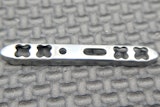The New Hampshire-based Hypertherm has been honored here in the past for forward-thinking and innovative teaching methods to help all kinds of people — from the recent high school graduate to the out-of-work parent, and even the person who simply wants a career instead of a job — to get the skills necessary to compete in today’s high-technology manufacturing landscape. Their program, the Hypertherm Technical Training Institute (HTTI), has been a boon to the area, had has effectively mitigated many of the serious problems the company was having when it came to hiring skilled employees during a major company expansion.
But recently, the company announced new initiatives that prove it’s not just thinking about those currently looking for work, either. Hypertherm’s HOPE (Hypertherm Owners Philanthropic Endeavors) Foundation has committed to five years of funding the Montshire Museum’s School Partnership Initiative, which aims to improve the STEM curriculum available to rural schools. The program, helmed by the Montshire Museum of Science in Norwich, Vt., aims in part to provide STEM education in an area where schools simply can’t afford the necessary resources.
Greg DeFrancis, Director of Education at the Montshire Museum, says, “The Montshire Museum works together with these (rural) schools by providing teacher professional development, curriculum resources and classroom support over an extended period of time.” In essence, it’s a supplemental tool to help teach these kids, who may not have access to this kind of knowledge otherwise, about the potential of a science or technology career.
Hypertherm has also been supporting of a traveling exhibition at the Museum called “How People Make Things,” which tells the story of how people, ideas and technology come together to create the things people use on a day-to-day basis. Along with children’s activities based on real manufacturing tools, Hypertherm’s Powermax30 cutting tool is demonstrated live for the curious onlookers.
In the current job skills economy, many manufacturers are struggling just to find skilled employees. Others are trying to devise new ways to train people on the technology-based processes that make up many plant floors today. But Hypertherm has taken its role in education to the next level, and according to Michelle Avila, public relations manager at Hypertherm, that commitment is just part of its culture.
She says, “Hypertherm’s mission is to provide our customers with the best cutting products and services in the world, promote the well-being and development of our Associates, and enrich our communities and environment. We believe best in class companies have a responsibility to the greater community that cannot be ignored.”
She echoes many of the same points that DeFrancis made about the inability for rural schools, particularly in the northeast, to find the necessary funding and personnel to keep strong STEM programs alive. Many teachers want to live in a more urban area, and there’s not enough money to go around to buy books or lab equipment. And it’s not difficult to see how this scenario would play out time and time again all over the country.
With that in mind, Hypertherm decided to step in. Avila says, “We think exposing and building interest and excitement in STEM subjects among children in elementary and middle school is important.”
Barbara Couch, Hypertherm’s vice president of Corporate Social Responsibility, adds to that idea: “As a company with a long history of innovation and technology, we have strong convictions about the importance of STEM programs to our future. Our goal is to expose and engage students in grades K-12 to STEM disciplines while also raising the level of awareness regarding rewarding careers in the advanced manufacturing field.”
Hypertherm is far from the first company to recognize that STEM education is lacking in many areas, as well as the fact that many young people in the U.S. have a outdated view of what modern manufacturing actually looks like. Avila says, “People are definitely surprised when they see our manufacturing facilities. I think they expect something dark and dirty with poor air quality.” Hypertherm is an ideal candidate to show otherwise, with clean facilities that are well-organized and littered with high-technology equipment. The environment is also vastly different than many people, with proper climate control, good air quality and lots of natural light.
The program is already helping change the minds of young students in the area. In collaboration with the already-strong HTTI program, Hypertherm seems primed to not only find and create the skilled employees necessary to cover today’s operations, but also inspire their future generations of machinists and engineers as well. It’s a forward-thinking, full-circle educational process, and one that seems as though it will become increasingly necessary for manufacturers to implement.
But it’s more than a long-term Hypertherm hiring program. Avila says, “In addition to being the right thing to do, volunteering is a tremendous way to build esprit de corps. It contributes directly to associate morale. People feel good when they know they are making a difference. In helping others, they are helping themselves through a feeling of purpose and accomplishment.” There’s no question the company is accomplishing a great deal already — a lesson, perhaps, that more manufacturers to take to their own plant floors and beyond.























